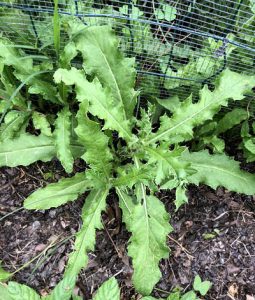Canada Thistle
By Pat Dickey, Fairfax Master Gardener
 I first became familiar with Canada thistle when I was a community gardener in Maryland and again here in Fairfax County, Virginia. Canada thistle seems to grow in the farmlands and natural areas that eventually become the places for parks and gardens. Yesterday I found it growing wild in the area next to the local dog park, which is also where my garden is located. A large area of thistle is growing 3 feet tall (1 m) there along the edge of the woods, still flowering but beginning to decline.
I first became familiar with Canada thistle when I was a community gardener in Maryland and again here in Fairfax County, Virginia. Canada thistle seems to grow in the farmlands and natural areas that eventually become the places for parks and gardens. Yesterday I found it growing wild in the area next to the local dog park, which is also where my garden is located. A large area of thistle is growing 3 feet tall (1 m) there along the edge of the woods, still flowering but beginning to decline.
In the garden, thistle is sprouting along the edge of the garden plots. When we planted our vegetables, there were thistle seedlings poking out of our landscape fabric in several places inside our fence. I wanted to pull them out, but when I tried they were prickly, and I was stabbed by the spines on their leaves. I knew from the beginning that this weed was going to fight with a vengeance to stay.
Canada thistle (Cirsium arvense) is an invasive perennial weed from the Sunflower family (Asteraceae). It arrived in the United States from Eurasia in the 1600s, probably coming here in crop seed shipments. By 1954, this noxious weed had become a problem in the natural areas of 43 states. It can be found throughout Canada and the northern United States, from northern California to Maine and south to Virginia.
 Leaves of the Canada thistle are alternate on the stem, simple, and oblong- to lanceolate-shaped. Young seedlings are covered with short hairs and are a dull green and become a dark green when they mature. There are spines on the leaf margins of both the seedlings and mature plants. The flowers and stems are spineless.
Leaves of the Canada thistle are alternate on the stem, simple, and oblong- to lanceolate-shaped. Young seedlings are covered with short hairs and are a dull green and become a dark green when they mature. There are spines on the leaf margins of both the seedlings and mature plants. The flowers and stems are spineless.
Reproduction occurs in two ways. Its creeping rhizomes extend horizontally and vertically as far as 3-1/2 feet (1 m) from the original plant, and the rhizomes frequently sprout dense patches of seedlings that look like small rosettes. Its flowers also produce seeds, nearly 1,000 per flowering shoot. The disk-shaped lavender flowers begin blooming mid-April until the end of May then fade in the summer. They then turn pale brown with feathery hairs (pappas) containing seeds (achemes) that can float a long distance in the wind. These seeds are viable in the soil for 10 to 20 years.
This weed prefers to grow in infertile, barren areas that have clay soil with full sun and adequate moisture. It also does well in tilled areas or on any disturbed ground without a proper groundcover. Plants emerge in the spring and then have another flush of growth in the fall. However, they will grow at any time and in any soil if there is adequate moisture. One plant can colonize an area 3 to 6 feet (1 – 12 m) in diameter in one or two years. Each plant also has a taproot that can be 3 feet deep, making its removal extremely difficult. The plants are dioecious and grow in patches of all male or all female plants. The female flowers are fragrant, and only females produce seed from cross pollination.
Control of Canada thistle in an organic garden is challenging. The carbohydrate reserves in the root system allow the plant to regrow after shoots have been destroyed. Tilling the soil will segment the roots and stimulate new plants to develop. It only takes about 15 days for new shoots to emerge from any remaining roots and shoot pieces. Small roots can survive at least 100 days without any nutrient replenishment. A spading fork can be used to dig down and carefully remove the rhizomes without breaking them into many pieces. Persistent hand cutting the seedlings with a pruner can begin to starve underground stems. Black plastic can also be tried to smother the thistle. Any control should take place before the flowers form seeds, but none of these controls will completely eliminate Canada thistle.
References
• Canada Thistle, KG Beck, Colorado State Univ Extension
• Organic Management of Canada Thistle, Greta Gramig and Clair Keene, North Dakota State
University Extension
• Canada Thistle, Virginia Tech Weed ID Guide
• Canada Thistle, Oregon State University
…updated 2023